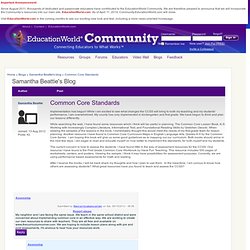

The art of the metaphor - Jane Hirshfield. Series Of Good Dan Pink Videos To Use With Students. I’ve written a lot about Daniel Pink’s writings on motivation over the years.

Thanks to Pam Moran, I recently discovered a series of short videos Dan did for the Patterson Foundation that would be good to use with students. Actually, Dan did one interview with the Foundation, and they elegantly turned them into bite-size ones that I think are perfect for the classroom. Some could just be shown to provoke a student response and discussion and others, like his One Sentence Project, presents specific next steps: Here’s the one on The One Sentence Project, and here are also links that give more information on it: Classroom 2.0 LIVE! - Home. Education World Community. Samantha Beattie.

Writers Club. So You Want to Do Mystery Skype? Mystery Skype is one of those ideas I wish I had thought because it just so fun but instead I was lucky enough to hear about it from Caren MacConnell.

The concept is simple: classrooms Skype call each other and try to guess where the other classroom is located either in the United States or in the world. There are many great resources out there but for my own sanity I am creating one list for future reference:Before the call:Sign up – there are many places to sign up and some are even grade level based. I signed up a couple of places but also tweeted it out; the response was immediate as a lot of people are doing this. If you would like to sign up: Decide on a date and time – don’t forget to consider in timezones.Prepare the kidsWe wanted to know facts about our own state so that we would be ready for any question. We therefore researched the following questions: climate, region, neighboring states, time zone, capital, famous landmarks, geographical location.
15 Things Teachers & Students Can Do With Edmodo. Last week the Wall Street Journal had an article announcing that Edmodo had received a $15 million venture capital investment from the founder of LinkedIn and a former VP of Facebook.

That article gave me the idea for this post of fifteen things teachers and students can do with Edmodo. For those not familiar with Edmodo, in a nutshell it is a microblogging system designed specifically for teachers and students. Using Edmodo teachers can create a microblogging network for their classes. Edmodo allows teachers to create a group specifically for their students and exclude those not invited to the group. Edmodo provides teachers with a place to post assignment reminders, build an event calendar, and post messages to the group. Here are fifteen things teachers and students can do with Edmodo. 1. 2. 3. 4. 5. 6. Google Drive Versus Evernote: Which Is Better For iOS Users? Google released version 1.1 of Google Drive for iOS Monday.

Now iPhone and iPad users can edit Google Docs natively on their devices for the first time. With 5GB of free storage, integration with other Google services, and powerful text and image recognition when searching for files, Google Drive is now a formidable challenger to Evernote on iOS. I. Information Literacy Quiz. Web literacy: Where the Common Core meets common sense. We believe it’s essential for every teacher to develop lessons that challenge students to learn how to verify sources; here’s one example By Alan November and Brian Mull Read more by Contributor May 25th, 2012.

Five technology skills every student should learn. Readers say technology literacy is about much more than learning how to use certain applications By Meris Stansbury, Associate EditorRead more by Meris Stansbury September 4th, 2012.

Why more schools aren’t teaching web literacy—and how they can start. Fourteen years after we first published ‘Teaching Zack to Think,’ here’s a new three-part framework for making sure students are internet savvy By Alan November and Brian MullRead more by Contributor May 8th, 2012 If you follow the dictate that we teach what we test, it’s understandable why schools haven’t spent more time preparing students to be web literate since NCLB was passed.

In 1998, a 15-year-old high school student used the personal website of a professor at Northwestern University, Arthur Butz, as justification for writing a history paper called “The Historic Myth of Concentration Camps.” That student, who we will call Zack, had been encouraged to use the internet for research, but he had not been taught to decode the meaning of the characters in a web address. When he read the web address, he assumed that the domain name “northwestern.edu” automatically meant it was a credible source. Without web literacy, Zack believed Butz’s explanation.
14 Steps to Meaningful Student Blogging.
Swindle - Discussion Questions. Discussion QuestionsUse our LitLovers Book Club Resources; they can help with discussions for any book: • How to Discuss a Book (helpful discussion tips)• Generic Discussion Questions—Fiction and Nonfiction• Read-Think-Talk (a guided reading chart) Also consider these LitLovers talking points to help get a discussion started for Swindle: 1.

How would you describe Griffin Bin, "The Man With the Plan"? Do admire him? 2. 3. 4. 5. 6. 7. 8. (Questions by LitLovers. Top of page.